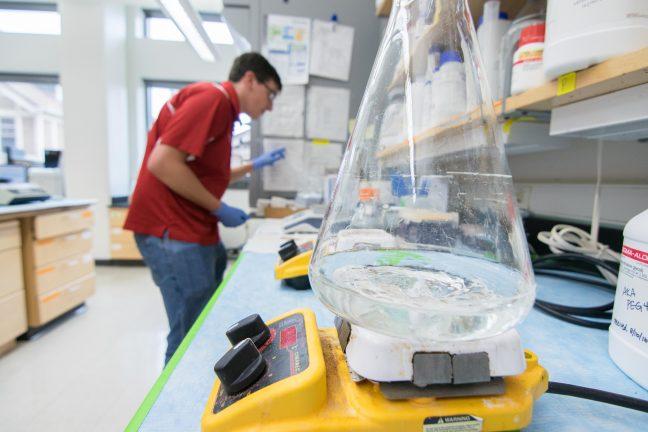Every month this semester, The Lab Report will feature a different undergraduate-research assistant on campus and their experience in the lab.
Nancy Keller Lab, Microbial Sciences Building
Most students on campus walk into work everyday hoping that mold hasn’t infested their left-over dishes.
But junior microbiology student Andrew Sukowaty isn’t most students.
Sukowaty currently works as a research assistant for Dr. Nancy Keller’s lab in the University of Wisconsin Microbiology Department studying mold that produces a toxin called aflatoxin, or as Keller describes it, “the most potent carcinogen to humankind.”
The lab specifically experiments with growing the fungi genus Aspergillus to observe and regulate the production of aflatoxin, a poisonous metabolite that has become a rising threat to global food security.
“It’s grown on me just because I’ve been working with it for a year,” Sukowaty said.
Keller was inspired to learn and conduct more research about fungal toxins after seeing the detrimental effects of Aspergillus firsthand as a young Peace-Corps volunteer in the south-African country of Lesotho, where she taught junior high school.
“The students I taught would get food from other countries,” Keller said. “But a lot of times the food was bad and it would make the kids sick, and I realized later it’s because there was fungus growing in it and probably some of the toxins I work with now.”
According to the Food and Agriculture Organization, aflatoxin affects 25 percent of the world’s crops before, during and after harvest. The most vulnerable, however, are those living in sub-saharan Africa, where aflatoxin contaminates staple food crops such as corn, sorghum and peanuts, according to a study by the United Nations.
Keller believes this issue is a serious medical problem in the developing world.
“So many people get liver cancer from this in Africa and Asia,” Keller said. “It actually suppresses your immune system so you’re more susceptible to other immune diseases.”
Developing countries, however, are not the only ones experiencing the wrath of aflatoxin. In the U.S. alone, aflatoxin costs the corn industry $225 million per year, according to a report in APS.
In efforts to lessen these impacts in the future, Sukowaty and his mentor, Brandon Pfannenstiel, are currently experimenting with removing or keeping one of the proteins called sntB in fungus A. flavus, which they believe is responsible for the release of aflatoxin.
“We have an idea that [sntB] is a heterochromatin remodeler, which means basically that it’s a protein involved in unpackaging genes when needed,” Sukowaty explained, like when A. flavus unpacks the aflatoxin gene to attack another fungus. “So we’ve deleted sntB and we’ve seen differences in aflatoxin production.”
But the absence of sntB in A. flavus doesn’t just affect aflatoxin production, it also affects the fungus developmentally, he said. This means that scientists could potentially manipulate physical characteristics such as reproductive structures.
In one experiment where Sukowaty deleted sntB from A. flavus, he noticed the fungus did not form sclerotia — rounded bodies that grow on the fungus and hold sexual spores.
And, just like changing the medium on which an artist paints affects the image, changing the media on which A. flavus lives inside petri dishes affects its growth.
“We’re constantly changing what media we grow stuff on to see what works and what doesn’t,” he said. “I recently did potato dextrose agar [media], and flavus grew completely differently…Any time a new media is involved, something cool happens.”

Riley Steinbrenner/The Badger Herald
On these media, Sukowaty grows up his genetic variations of A. flavus, called strains.
The strains either contain or do not contain sntB — all which, depending on the media, affect the growth of A. flavus differently.
“I think the most fun part is just discovering whatever’s happening.”

Riley Steinbrenner/The Badger Herald
By continuing to develop methods that weaken development of A. flavus and production of aflatoxin, the Keller lab hopes to lessen the toxin’s impact on food crops and people in developing countries.
Sukowaty, however, agrees with Keller that the possibility of applying their knowledge in regulating the fungus that contaminates food in developing countries anytime soon will be “astronomically difficult.”
“With microbes, everything needs to be met perfectly to get a result,” he said. “Especially with flavus, which is hard to deal with in lab. Things don’t work a lot of the time.”
Because A. flavus easily contaminates with its airborne spores, sometimes Sukowaty has to start experiments over if he notices abnormalities in them, which takes two weeks to appear.
Sukowaty also recalled he and Pfannenstiel once deleted sntB from A. flavus thinking it would prevent creation of aflatoxin, but it still produced the toxin — only in small amounts, however.
“It’s definitely made me take everything with a grain of salt, where if something goes wrong it’s not the end of the world. Just try it again, try it differently. Adapt something.”
Despite the tediousness of working with fungi, the junior bacteria-enthusiast encourages younger undergraduates not to be stingy when choosing labs.
And for Keller, enthusiasm is most important in a potential research assistant.
“We’re not expecting anyone to come in with a lot of experience,” she said. “Even if someone hadn’t done any science before and they’re just really eager and convey that interest…that for me is a really big [factor] that I look for.”



